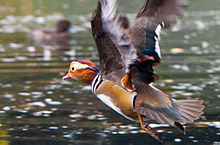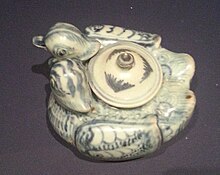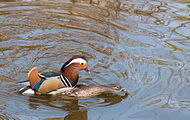
Male and female mandarin ducks at
Description
The adult male has a red bill, large white crescent above the eye and reddish face and "whiskers". The male's breast is purple with two vertical white bars, and the flanks ruddy, and he has two orange "sails" at the back (large feathers that stick up like boat sails). The female is similar to the female wood duck, with a white eye-ring and stripe running back from the eye, but is paler below, has a small white flank stripe, and a pale tip to its bill.[3]Both the males and females have crests, but the purple crest is more pronounced on the male.
Like many other species of ducks, the male undergoes a moult after the mating season into eclipse plumage. When in eclipse plumage, the male looks similar to the female, but can be told apart by its bright yellow-orange or red beak, lack of any crest, and a less-pronounced eye-stripe.
Mandarin ducklings are almost identical in appearance to wood ducklings, and very similar to mallard ducklings. The ducklings can be distinguished from mallard ducklings because the eye-stripe of mandarin ducklings (and wood ducklings) stops at the eye, while in mallard ducklings it reaches all the way to the bill.[citation needed]
Mutations
Various mutations of the mandarin duck are found in captivity. The most common is the white mandarin duck. Although the origin of this mutation is unknown, the constant pairing of related birds and selective breeding is presumed to have led to recessive gene combinations leading to genetic conditions including leucism.Distribution and habitat
The native range of the mandarin duck, and parts of its introduced range where it is established breeding
Breeding Native resident Migrant Winter visitor Introduced resident
Specimens frequently escape from collections, and in the 20th century, a large, feral population was established in Great Britain; more recently, small numbers have bred in Ireland, concentrated in the parks of Dublin. Now, about 7,000 are in Britain, and other populations on the European continent, the largest in the region of Berlin.[5] Isolated populations exist in the United States. The town of Black Mountain, North Carolina, has a limited population,[6][dead link] and a free-flying feral population of several hundred mandarins exist in Sonoma County, California.[citation needed] This population is the result of several ducks escaping from captivity, then reproducing in the wild.[3] In 2018, a single bird was seen in New York City's Central Park.[7]
A mandarin duck seen in Central Park.
Behaviour
Breeding
A mother with ducklings in Richmond Park, London, England
Food and feeding
Male flying in Dublin, Ireland
Threats
Predation of the mandarin duck varies between different parts of its range. Mink, raccoon dogs, otters, polecats, Eurasian eagle owls, and grass snakes are all predators of the mandarin duck.[9] The greatest threat to the mandarin duck is habitat loss due to loggers. Hunters are also a threat to the mandarin duck, because often they are unable to recognize the mandarin in flight and as a result, many are shot by accident. Mandarin ducks are not hunted for food, but are still poached because their extreme beauty is prized.[9]In culture
Chinese culture
A Yuan Dynasty porcelain teapot representing a mandarin duck pair
Porcelain winepot in the form of a mandarin duck, decorated in overglaze enamels, Qing dynasty, circa 1760
A Chinese proverb for loving couples uses the mandarin duck as a metaphor: "Two mandarin ducks playing in water" (simplified Chinese: 鸳鸯戏水; traditional Chinese: 鴛鴦戲水; pinyin: yuānyāng xì shuǐ). A mandarin duck symbol is also used in Chinese weddings because in traditional Chinese lore, they symbolize wedded bliss and fidelity. Because the male and female plumages of the mandarin duck are so unalike, yuan-yang is frequently used colloquially in Cantonese to mean an "odd couple" or "unlikely pair" – a mixture of two different types of same category. For example, the drink yuanyang and yuan-yang fried rice. Mandarin ducks featured on the flag of Weihaiwei during British rule.
Korean culture
For Koreans, mandarin ducks represent peace, fidelity, and plentiful offspring. Similar to the Chinese, they believe that these ducks mate for life. For these reasons, pairs of mandarin ducks called wedding ducks are often given as wedding gifts and play a significant role in Korean marriage.[10]Japanese culture
Similarly, in Japanese the ducks are called oshidori (おしどり/オシドリ/鴛鴦) and are used in the phrase oshidori fūfu (おしどり夫婦, "a couple of lovebirds/happily married couple").Gallery
- Drake in eclipse plumage
- Egg, Museum Wiesbaden collection
- A pair of incense boxes shaped like mandarin ducks
The native range of the mandarin duck, and parts of its introduced range where it is established breeding
Breeding Native resident Migrant Winter visitor Introduced resident

















No comments:
Post a Comment
Note: Only a member of this blog may post a comment.